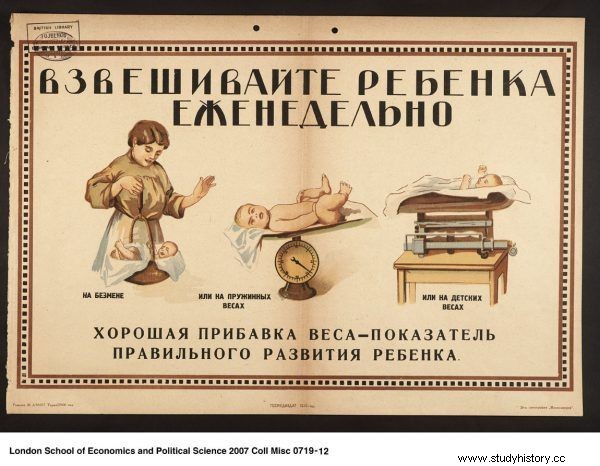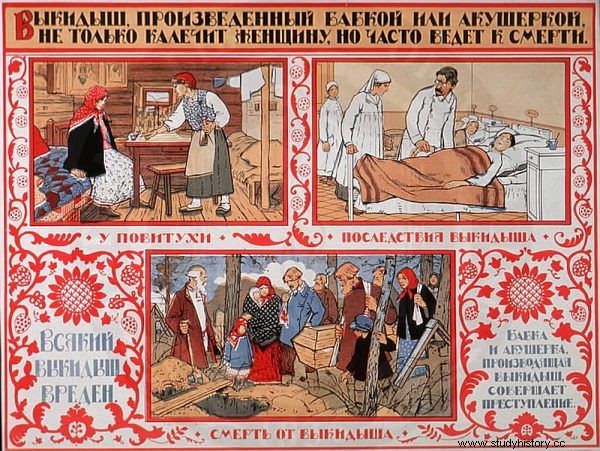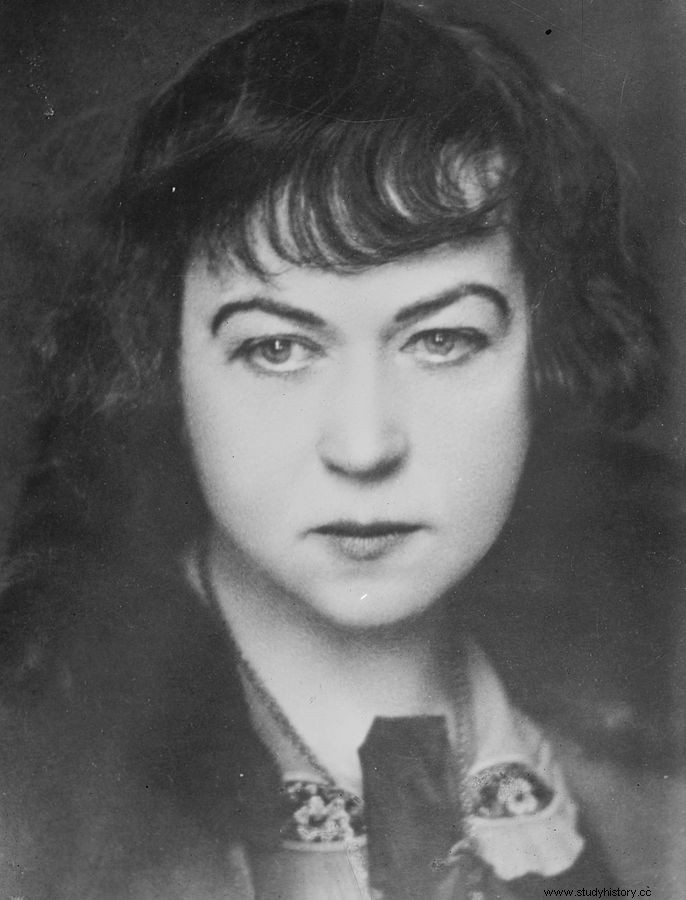In 1987 alone, over six million legal abortions were performed there. Skrobanks were available to the public, free of charge, and guaranteed by the state health service. Contrary to contraception. Why was it easier for women to terminate a pregnancy than to protect against it?
In the Soviet Union, abortion was treated as a method of contraception. The best, because it is 100% effective and, in addition, free of charge. Skrobanka, as they write in the book "Grażdanin N.N. Everyday Life in the USSR ”Marta Panas-Goworska and Andrzej Goworski, was only an unpleasant formality.
To undergo the procedure, all you had to do was go to the doctor, provide your details and the reason for the termination of the pregnancy. For example, an acceptable justification for the reluctance to enlarge the family was "material reasons" . The nurse conducted a short interview and then read to the patient the content of the official decree of 1955:
The Soviet State's efforts to promote the protection of motherhood and further increase the cultural awareness of women, who are an active part of all areas of the economic and cultural life of the country, make it possible to lift the ban on abortion law.

Soviet posters recommended weighing the baby every week ... and meanwhile many women were looking for a way not to weigh ... (Source:Library of the London School of Economics and Political Science).
This document repealed Stalin's ban on abortion almost 20 years earlier, in 1936. After completing these simple formalities, the patient was directed to a doctor's office.
No anesthesia
The massive abortion system in the USSR did not work unscathed. Women were not entitled to anesthesia. Only occasionally they had the option of using it for an additional fee. Instead of anesthesia, the patients were given… ice . Doctors waited for everything to numb from the cold and went to work - Polina Bachlakova, her own grandmother, told Polina Bachlakova, a young journalist.
In addition, Soviet women had to endure the brasiness of medics. Doctors not only disrespected them, but also mocked them. Examples of such treatment were given by Ekaterina Nikolaeva, the author of the text "I do not want to apologize for being a woman". It was published in the 1980s in one of the Moscow weeklies. Hurry up, I'm sick of your stupidity The woman who entered the office heard and looked at the medic's rubber gloves dripping with blood. N Think again next time. You all want sweets, but you are not going to pay for it Another doctor chided his patient.
Nikolaeva's article shocked Alexandra P. Biryukova, the highest-ranking woman in the government of the time. On her initiative, the Ministry of Health carried out an inspection of the situation. Its result showed that the scale of the abortion is shocking. At a specially convened press conference, Biryukova announced that the government was going to develop the contraceptive industry. As a result, women would no longer have to have an abortion.
But before the availability of contraception became more accessible, the abortion black market had developed . Many women decided to undergo private procedures due to the terrible conditions in state health centers. Some paid doctors, others sought help from the so-called "Aunts". What was the visit to my aunt like? This is how the authors of the book "Grażdanin N.N. Everyday life in the USSR ”:
She gave me drugs, eat them, she says, then put aloe vera inside and ordinary tansy. And let the old man finally hit the belly with all his might.

Tansy and a strong kick. Such a prescription for an unwanted pregnancy may have been encountered by Soviet women in their "aunts" (photo:AnRo0002, public domain).
Mass scraping, both legal and made thanks to the "aunts", took a heavy toll. According to the New York Times in 1989, 600-700 women died from post-abortion complications in a year in the Russian Republic. Many patients after surgery could not have children at all. Others, when they became pregnant again and decided to terminate her, gave birth early.
Women on the abortion conveyor
Despite the dangers of abortion, statistics show that one in ten women in the USSR underwent an abortion. Record holders have had over a dozen treatments under their belt. Polina Bachlakova's grandmother passed 12 of them! The girl was shocked by the fact that this caring matron, who spent most of her life in lines for meat or at a borscht cauldron in the kitchen, could have had such experiences behind her. This is how the grandmother of the family talked about the atmosphere in the hospital:
Many women while waiting for an abortion felt like they were sitting on a conveyor belt. Every morning at the hospital at least ten women were lining up to terminate a pregnancy.
Similar reports can be heard from many women from the countries of the former Soviet republics. In the article "USSR. Sex That Wasn't There is quoted as Maria Ivanova. She got married in 1950, so at the time when abortion was illegal:
О we have not heard of contraceptives. I got married and got pregnant right away ... I started running for abortions ... At the beginning, such surgeries were forbidden at all, they were performed in the underground, at my grandmother's, at my friends' doctors. No anesthesia, "live".

Seeking help "from my grandmother" could have ended tragically for a woman. Soviet poster from 1925 informing about the dangers of abortion (public domain).
The pain was wild. You go through something like this and think, "The hell is this sex!" You sit in the kitchen waiting for your husband to fall asleep. As long as he did not pick on. And how many women have died because of these abortions - fear! My husband's brother's wife died due to bleeding during termination of pregnancy.
Reusable condoms
The shocking abortion statistics of the USSR were primarily the result of a shortage of contraceptives. The level of sexual education for both women and men was also low. The husband's role was limited to driving his wife to the surgery in the car and taking her away " after all ” .
Couples did not talk to each other about protection against unwanted pregnancy. There was not much to talk about anyway. The authors of the book "Grażdanin N.N. Everyday life in the USSR ”:
Product 2 (the official name of the condom) was a scarce commodity and, apart from the pharmacies in Moscow and Leningrad, it was almost a miracle to buy it. But even the inhabitants of these cities could not buy more than ten at a time. Hence, the reusable disposable condoms mocked in jokes actually existed. They could be bought in the Soviet Union.
Anyway - one might add by the way - what would be the point of spreading precautionary measures against pregnancy in a country where ... there is no sex ? The whole world learned that the USSR is such a country in July 1986 from Lyudmila Nikolaevna Ivanova, one of the participants of the Leningrad-Boston telemost. During a Soviet-American program, a Western participant asked if the advertisements in the Soviet Union, as in the United States, were sexually suggestive. In response, she was told no - and that's because there is no sex at all in the USSR!
280 million
Abortion was legal for most of the Soviet Union's existence. Russia was the first country in the world to legalize abortion. It happened on November 19, 1920, even before the proclamation of the creation of the USSR. The Soviets overtook other countries by almost half a century.

The Soviet Union was the first to legalize abortion in 1920 thanks to the People's Commissar for Social Affairs, Aleksandra Kołłontaj. She believed that, inter alia, in this way he will eliminate bourgeois morals in the Soviets (George Grantham Bain Collection, public domain).
How many abortions were performed during the almost 70 years of the USSR? Despite the almost twenty-year break (between 1936 and 1955) in which he withdrew from " sexual revolution ”, the balance sheet of the era is shocking. The data available in the archives of the American scientist Robert Johnstone give the number 282 429 483 procedures in the years 1922-1991. In turn, in the publication entitled History of Abortion. Statistics in Russia and the USSR from 1900 to 1991 ", we can read that the total number of abortions in 1954-1990 was over 251 million.
Currently, abortion is still legal in Russia. On average, however, " is performed during the year only "one million treatments. That's six times less than in the 1980s in the USSR…
